2025 Doyle Fellows
Matthew (Matt) Allen
School/Major: University of New Hampshire '27, Environmental Conservation and Sustainability
Mentor: Trevor Mattera (PREP)
Project Title: Great Bay Estuary Oyster & Eelgrass Restoration Project

Emma Barker
School/Major: Bowdoin College '25, Earth and Oceanographic Science
Mentor: Dr. Linas Kenter
Project Title: Estuarine Aquaculture Research, Restoration, and Extension
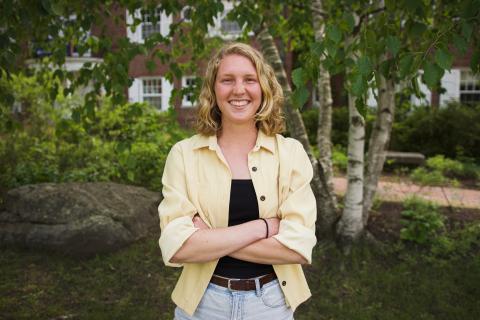
School/Major: Northeastern University '25, Environmental & Sustainability Sciences
Mentor: Dr. Steve Jones
Project Title: Human Impacts on Estuarine Ecosystem Conditions
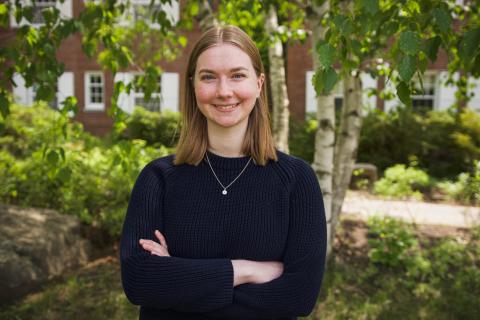
School/Major: University of New Hampshire '25, Environmental Conservation and Sustainability
Mentor(s): Lisa Wise, Dr. Alyson Eberhardt, Gracie Ballou
Project Title: Flood Ready Neighborhoods – Youth Engagement

School/Major: University of New England '25, Aquaculture and Aquarium Science
Mentor: Michael Doherty
Project Title: Aquaculture Education

School/Major: Tufts University '27, Documentary Filmmaking for Aquatic Conservation
Mentor: Brian Yurasits
Project Title: Coastal Science Communications
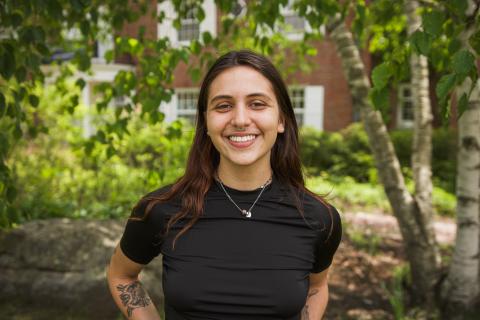
School/Major: Brandeis University '25, Environmental Studies
Mentor: Lara Martin (PREP)
Project Title: Great Bay Estuary Bottom Habitat Monitoring Project

School/Major: University of New Hampshire '27, Environmental Science
Mentor: Dr. Gabby Bradt
Project Title: Blue Crab Monitoring

School/Major: University of New Hampshire '25, Zoology
Mentor(s): Lisa Wise, Dr. Alyson Eberhardt, Gracie Ballou
Project Title: Flood Ready Neighborhoods – Youth Engagement

Sage Dieffenbach
School/Major: University of New Hampshire Manchester '24, Biological Sciences
Mentor: Dr. Steve Jones
Project Title: Public Health implications of microbial pathogens and toxic chemicals in NH Shellfish
Miles Keefe
School/Major: University of New Hampshire '24, Geography
Mentor: Lisa Wise
Project Title: Climate Adaptation in Coastal New Hampshire
Anna Maccaroni
School/Major: University of New Hampshire '25, Sociology
Mentor: Dr. Lindsey Williams
Project Title: Human Dimensions of Fisheries and Aquaculture
Susan Pinard
School/Major: Southern New Hampshire University '24, Sustainability
Mentor: Trevor Mattera (PREP)
Project Title: Great Bay Estuary Oyster & Eelgrass Restoration Project
Adam Ramsden
School/Major: University of New Hampshire '25, Marine, Estuarine and Freshwater Biology
Mentor: Dr. Linas Kenter
Project Title: Estuarine Aquaculture Research and Extension
Shaelin Wood
School/Major: Southern Maine Community College '24, Applied Science of Horticulture
Mentor: Michael Doherty
Project Title: Aquaculture Education
Caitlin Borey
School/Major: Texas A & M University, Coastal Environmental Science and Society
Mentor: Lara Martin (PREP)
Project Title: Great Bay Estuary Bottom Habitat Monitoring Project
Jillian Currier
School/Major: University of New England, Marine Affairs
Mentor(s): Dari Christenson & Julia Peterson
Project Title: Marine Education and Appledore Island Cruises” and “Estuarine Education and Outreach Landscape Analysis"
Zoe Kendall
School/Major: University of New Hampshire, Earth Sciences: Oceanography
Mentor: Dr. Steve Jones
Project Title: Ocean Acidification Impacts on Shellfish in New Hampshire
Kennedy McGrath
School/Major: University of New Hampshire, Marine, Estuarine and Freshwater Biology
Mentor: Dr. Linas Kenter
Project Title: Aquaculture Research and Development
Kassandra Moening
School/Major: University of New Hampshire, Nutritional Sciences
Mentor(s): Dr. Sherman Bigornia, Dr. Gabby Bradt, Dr. Lindsey Williams
Project Title: Human Dimensions of Fisheries - Nutrition
Alexa Newton
School/Major: White Mountains Community College, Environmental Science
Mentor: Trevor Mattera (PREP)
Project Title: Great Bay Estuary Oyster & Eelgrass Restoration Project
Asher Panikian
School/Major: University of New Hampshire, Marine, Estuarine and Freshwater Biology
Mentor: Kelsey Meyer
Project Title: Great Bay Aquaculture Oysters & Green Crab Studies
Jackson Perkins
School/Major: University of New Hampshire, Marine, Ocean Engineering
Mentor(s): Michael Chambers & Michael Doherty
Project Title: Aquaculture Research and Economics
Karena Sazo
School/Major: University of New Hampshire, Marine, Environmental Conservation and Sustainability
Mentor(s): Dr. Lindsey Williams
Project Title: Human Dimensions of Fisheries - Management
William Schechter
School/Major: Clark University, Political Science
Mentor(s): Dr. Alyson Eberhardt, Mikaela Heming
Project Title: Human Dimensions of Fisheries - Management
Madison Wilson
School/Major: University of New Hampshire, Marine, Estuarine and Freshwater Biology
Mentor(s): Kelsey Meyer
Project Title: Great Bay Aquaculture Oysters & Green Crab Studies
Billy Bachelder
School/Major: Brown University '25, Biology with a Marine Biology Track and a minor in Visual Art
Mentor: Dr. Gabby Bradt, NH Sea Grant and Michael Masi, Southern Maine Sustainable Shellfish
Chris Chase
School/Major: University of Connecticut '23, Fisheries Management and Policy
Mentor: Dr. Linas Kenter
Ali Guenthardt
School/Major: Tulane University, Environmental Biology with a minor in Public Health
Mentor: Dr. Steve Jones
Chloe Scordianos
School/Major: University of New Hampshire '24, Ocean Engineering
Mentor: Dr. Lindsey Williams, Lisa Wise, Diane DeVries
Anya St Martin
School/Major: Sarah Lawrence College '24, Environmental Studies
Mentor: Dr. Gabby Bradt
Kayla Tozier
School/Major: University of New Hampshire '23, Earth Sciences with an Oceanography track
Mentor: Dari Christenson, Lisa Wise
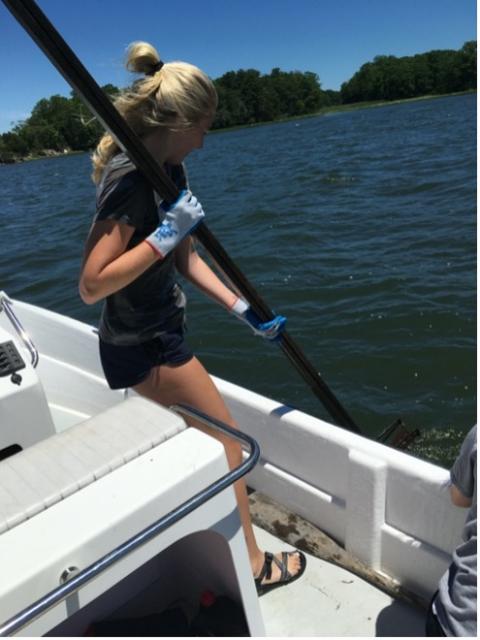
Shelly Lancaster
School/Major: University of New Hampshire '22, Wildlife and Conservation Biology, Minors in Marine Biology and Environmental Conservation and Sustainability
Mentor: Dr. Steve Jones
The focus of Shelly's summer was the health and safety of seafood in New Hampshire with specific regard to mussels and oysters. Shelly was involved with a NOAA project focusing on trace metal uptake by blue mussels. Varied pH in the aquaria of mussels mimics ocean acidification, which is the focal point of that study. She was also involved with a bacterial surveillance project in the Great Bay area. Bacteria in the genus Vibrio are potentially pathogenic to humans and are identified in lab cultures and their DNA is tested for potential pathogenicity. She also worked on an oyster re-submergence project to determine how temperature impacts the bacteria Vibrio parahaemolyticus which is the leading cause of seafood-borne illness in the world. Finally, they worked to evaluate the health of oyster restoration sites on nine New Hampshire oyster farms. Coming from a non-microbiological background, Shelly found it interesting to see how her greater interest in ecology is so influenced by microbiological processes and organisms.
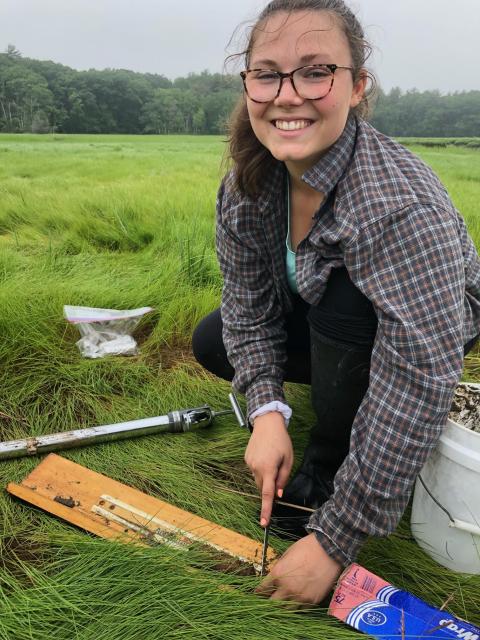
Kayla Tozier
School/Major: University of New Hampshire '23, Earth Sciences with an Oceanography track
Mentor: Dr. Gregg Moore
Kayla worked alongside Hanna Mogenson, a UNH Master’s student, on her microplastics study in the salt marshes of Hampton/Seabrook, NH. Her work involved deploying manta trawl nets in the currents, digesting organics in the lab, as well as joining in on other happenings during the summer, such as birding and taking porewater samples in the marsh. She not only helped her with sampling and lab work, but also took her own beach samples as a side project that branches off of her study. The goal of taking these beach samples was to sort through them on the dissection microscope to visually ID and record any microplastics found in the high wrack line and the high tide line to eventually gather data about the differences in microplastic abundances based on the tide. Kayla was immersed into the exciting and complicated world of field work, where she learned many skills in taking samples, recording data, and understanding the logistics and complications behind scientific research. The most interesting piece to Kayla was analyzing beach sand samples under the microscope.
Victoria Bamford

School/Major: Eckerd College '20, Environmental Studies and Anthropology
Mentor: Dr. Alyson Eberhardt
For her Doyle Fellowship, Victoria worked with the Coastal Landowner Technical Assistance Program (LTAP) to help identify and address common landowner questions and themes related to the flooding and erosion they experienced on their coastal properties in New Hampshire. She did this by analyzing site visit reports generated by LTAP staff using the qualitative data analysis software, MaxQDA, and was able to use her findings to identify knowledge gaps among landowners. This information helped NH Sea Grant and the NH Department of Environmental Services pinpoint what resources already existed to bridge these gaps and what has yet to be created and implemented as part of LTAP.
She has since developed accessible guides for photo monitoring and erosion monitoring to give landowners a framework for collecting long term data that compliments their observations of these natural occurrences.
Olivia Deblois-Hill
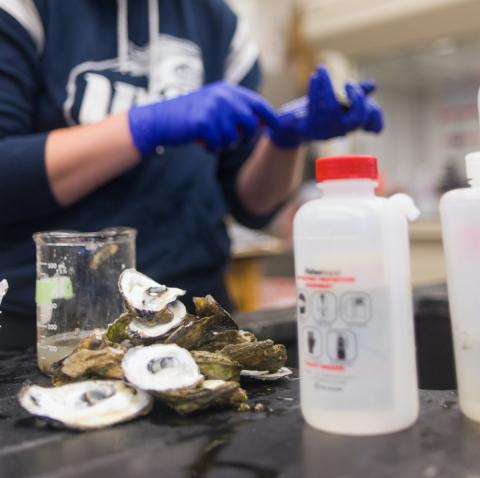
School/Major: University of New Hampshire '22, Biomedical Sciences/Medical Microbiology
Mentor: Dr. Steve Jones
Olivia Deblois-Hill, a Biomedical Sciences/Medical Microbiology junior at the University of New Hampshire, spent her 2020 summer working with Dr. Steve Jones. Her project focused on the microbiome of oysters and how Vibrio parahaemolyticus is affecting New England oyster farms and public health.
Before this opportunity, Olivia had little lab experience outside of classes and learned a lot in just a short amount of time. She intends to carrying the lab skills she gained this summer beyond her resume. She also made valuable career connections that will last a lifetime. "This fellowship allowed me to have some sense of normalcy during 2020," said Olivia.
Cameron Flanagan
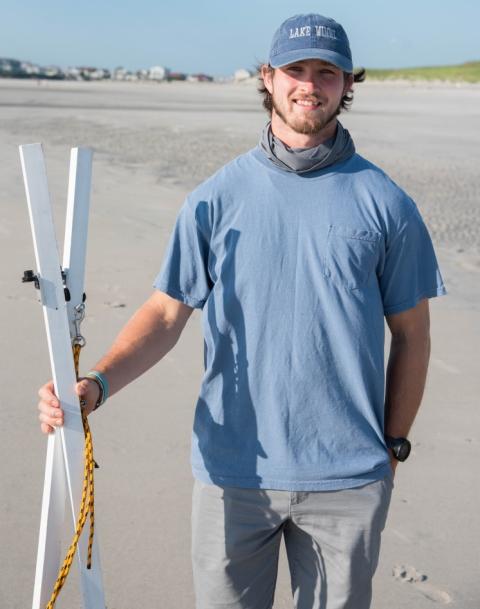
School/Major: Saint Anselm College '21, Biology with a minor in Environmental Studies
Mentor: Dr. Alyson Eberhardt
Cameron grew up on the NH Seacoast and was extremely excited to be able to work on such a valuable project so close to home. His Doyle Fellowship allowed him to apply his education to the Coastal Research Volunteers' beach profiling project. The beach profiling project tracks changes to the beaches of the NH Seacoast driven by erosion and accretion from storms, providing data for coastal municipalities concerned about the longevity of their iconic beaches.
Cameron gained professional experience by working with an amazing staff and was able to summarize the findings of the volunteer beach profiling study into publicly accessible fact sheets.
The goal of his work was to get the beach profiling data into the hands of stakeholders and beach managers so that our NH coastline is able to remain as resistant and resilient for the future. The fact sheets Cameron helped create were shared at the NH Sea Grant Biennial Research Symposium in January 2021, as well as directly with resource managers in coastal communities.
Alex Gross
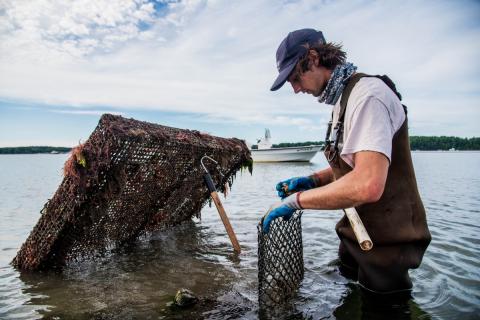
School/Major: University of New Hampshire '21, Environmental Science
Mentor: Dr. Steve Jones
During Alex Gross’ Doyle Fellowship, he helped Dr. Steve Jones with oyster sampling and monitoring for the presence of Vibrio spp. bacteria, in particular Vibrio parahaemolyticus. V. parahaemolyticus is a naturally occurring bacteria that has pathogenic strains which can cause food poisoning in humans.
In order to monitor levels of V. parahaemolyticus in NH's Great Bay, Alex took monthly oyster, sediment and water samples from two locations, Oyster River and Nannie Island. These samples were then processed and tested for the presence of Vibrio bacteria.
In addition to monitoring, Alex also helped Dr. Jones with his ongoing resubmergence study. When farmers sort through oysters for market, the oysters are exposed to high heat while out of the water, which can cause rapid increases in Vibrio levels, leading to food poisoning in humans. This study involved exposing oysters to the summer heat and tracking the change in Vibrio spp. levels over a 10-day period.
Due to COVID-19, many oyster farmers could not sell their product since restaurants were closed, and many of their oysters exceeded their optimal size range and lost commercial value. Alex assisted with NH Sea Grant’s oyster population enhancement project to provide financial relief to growers affected by COVID-19. Alex communicated with oyster farmers in the Great Bay and Hampton Harbor to help track the relocation of oversized oysters to experimental oyster reefs on each farmers site. The project also includes a yearlong monitoring program for growth, survival, and recruitment.
Alex was also part of the EPA’s National Coastal Conditions Assessment where a team of UNH staff sampled locations around the Seacoast for different water quality indicators. Throughout his fellowship, Alex learned many new skills in microbiology and gained hands on experience and insight into the research process.
“Having worked on oyster farms in the past I was really excited to learn more of the science behind why there are so many rules and regulations to mitigate Vibrio. This fellowship helped me take skills I learned in a classroom and apply them to real life research in a field I’m passionate about. It was rewarding to know the research I had done this summer can influence policies and regulations that will help New Hampshire shellfish growers in the future. I’m very thankful for this opportunity, and to have made connections with multiple shellfish growers and many UNH faculty members.”
Chuck Basile, UNH '20 Environmental Science
Mentor: Dr. Gabriela Bradt
Chuck Basile worked with the NH Green Crab Project during his Doyle Fellowship. Over the summer, he explored new techniques to increase soft-shell green crab production with a market development and growth component. His work involved visiting farmers markets with NH Community Seafood to increase consumer awareness of and demand for green crabs as a local, sustainable seafood ingredient.
Elizabeth Martin, UNH '20 Environmental Science
Mentor: Dr. Steve Jones
During Elizabeth Martin’s Doyle Fellowship, she helped Dr. Steve Jones with oyster sampling and monitoring for Vibrio bacteria and conducted a re-submergence study to observe the Vibrio parahaemolyticus growth when oysters are exposed to warm air temperatures. Elizabeth also looked at other bacteria called Halobacteriovorax that eat the Vibrio parahaemolyticus and could possibly be used to control the levels of V. parahaemolyticus in oysters.
V. parahaemolyticus is a naturally occurring bacteria that has some pathogenic strains that can cause food poisoning in humans. In order to monitor levels of V. parahaemolyticus in Great Bay, Elizabeth took monthly oyster, sediment, plankton, and water samples from two sampling locations, Oyster River and Nannie Island. The rest of the week was then spent processing these samples and testing for the Vibrio bacteria, which they identify using Polymerase Chain Reaction, also known as PCR.
Elizabeth also worked with the New Hampshire Department of Environmental Services and spoke with a number of NH oyster farmers on Great Bay to understand their pre-harvest techniques, advised the farmers on best practice to avoid Vibrio based on their results.
Throughout her fellowship, Elizabeth learned many new skills in microbiology, and also gained hands on experience and insight into the research process.
“It was really exciting to design my own research experiment that has the potential to help the oyster industry mediate the level of Vibrio bacteria in oysters, something I have never been able to do before. Overall this summer was a great learning experience and I am so thankful to be able to take part in research happening at UNH, especially on Great Bay”.
Elizabeth, who is a member of UNH's Women's Ski Team, was featured by the UNH Athletics Department in their Wildcat Summer series. Watch the video below and read more about Elizabeth's fellowship experience.
Taylor Merrick, Unity College '20 Marine Biology
Mentor: Dr. Gabriela Bradt
Taylor Merrick worked on the NH Green Crab Project for her Doyle Fellowship to help create a monitoring program for green crabs and a fishery market for this invasive species. A new aspect to the project this year was whether or not temperature will have a role in the molting cycle of Green Crabs. The question we were trying to answer is if there is a certain temperature that will cause more crabs to molt.
Taylor coordinated the Great Green Crab Hunts, which matched her interests in education and outreach, where she really felt in her element. She was also in charge of quadrat sampling, which aims to collect more in-depth data about what species and how many of them are in each location. A new challenge for Taylor was managing the Instagram page @nhgreencrabs, which she found very different from managing a personal social media account, but ultimately rewarding.
“Through this fellowship, I gained skills in research, data collection, coordination, organization, and social media presence. I chose this internship to broaden my skills within my field and introduce myself to the research side of marine biology. I am very grateful that my role in this project incorporated both research and education/outreach. I think the most important thing I gained from this summer is that I have chosen the right direction for myself: education and outreach. The research aspect is definitely a great experience to have and I do enjoy it, however it has shown me that education is truly my passion.”
Maggie Phillips, UNH '19 Environmental Science
Mentor: Mark Wiley
For her Doyle Fellowship, Maggie Phillips worked as a marine education intern. She developed marine science curricula, helped plan and market the 2019 National Marine Educators Association conference, and attended education and outreach events delivered by Sea Grant volunteers—the Marine Docents. These events include cruises with hands-on science, marine celebrations/festivals, and marine science field trips for middle school students. Maggie gained education experience by developing interactive lessons about the intertidal zone and collaborated with Sea Grant volunteers to create an online Seacoast Activities guide for conference attendees visiting the area for the first time this summer.
“All my experience has been on the research side of science, so it was really valuable to experience the outreach side—I found out that I love developing science curriculum! As a recent graduate, I have also benefitted so much from working alongside passionate Sea Grant staff and volunteers who give awesome career advice!”
Audrey Berenson, UNH Biomedical Science: Medical Microbiology
Mentor: Steve Jones, Oyster Farm Sanitation Practices
Nicole DeRoche, Saint Anselm College Environmental Science
Mentor: Gabby Bradt, Green Crab Fishery
Robert Lafreniere, UNH Marine, Estuary and Freshwater Biology
Mentor: Alyson Eberhardt, Healthy Coastal Ecosystems/Coastal Research Volunteers
As a NH Sea Grant Doyle Fellow, Robert developed and implemented a monitoring program to evaluate the success of sand dune restoration projects in NH. Robert also analyzed the findings to develop a summary report. He found that restored areas of the Harborside Dunes had a similar diversity of plants and density of beachgrass as the reference areas. He also had the opportunity to work with citizen scientist volunteers on projects such as beach profiling, eel monitoring, green crabs, and many others.
Erich Berghahn, UNH Marine Biology
Mentor: Michael Chambers, Aquaculture
Erich was in charge of the shrimp aquaculture system at UNH's Jackson Estuarine Lab, where he conducted water quality analyses, checked on the health and growth of the shrimp, calculated feed rations and maintained the culture system. He helped two other individuals learn how to set up this type of system for use in a local high school to teach students about aquaculture. Erich also provided tours of the shrimp system and helped with a shrimp taste test later in the summer.
Trevor Burns, UNH Marine, Estuarine and Freshwater Biology
Mentors: Alyson Eberhardt and Caitlin Mandeville, Coastal Research Volunteers
Trevor worked with Alyson and Caitlin on outreach and field work for several coastal research and habitat restoration projects, including oyster restoration in Great Bay and glass eel monitoring on the Oyster River in Durham. He produced a Story Map to communicate with stakeholders about the sand dune restoration activities carried out by the UNH Coastal Habitat Restoration Team in five NH and MA coastal communities.
Meghan Woods, UNH Marine, Estuarine and Freshwater Biology
Mentor: Gabby Bradt, Fisheries
Meghan worked with Gabby to collect invasive green crabs in Great Bay and along the N.H. coast. Meghan monitored their morphological signs to determine when green crabs might molt in order to explore the feasibility of developing a softshell crab market. She also worked with Gabby to deliver newly molted green crabs to local chefs so they could test recipes using this species.
Jake Levine, UNH Marine, Estuarine and Freshwater Biology
Mentors: Gabriela Bradt and Michael Chambers, Fisheries and Aquaculture
Jake worked with Gabby on an improved edible seaweed identification booklet for those who are interested in adding the "vegetables of the sea" to their everyday meals. Once completed, this booklet will contain basic information on up to 18 common edible seaweed species along the New Hampshire coastline. He also worked with Michael on the construction of a tumble culture tank for the growth of Gracilaria and Ulva and the improvement of a kelp incubation tank at the Coastal Marine Lab in New Castle, N.H.
Kendall Young, UNH Marine, Estuarine and Freshwater Biology
Mentor: Alyson Eberhardt, Healthy Coastal Ecosystems/Coastal Research Volunteers
Kendall worked with Alyson on a variety of activities with the Coastal Research Volunteers including dune restoration and eel monitoring. She worked in the dunes at Hampton, Salisbury and Plum Island doing both community outreach and restoration and implementing an experiment she designed to look at dune plant growth. She also worked on a project assisting the Sagamore-Hampton Golf course obtain certification under the Audubon Cooperative Sanctuary Program for Golf by monitoring the water quality at the golf course and planting stream buffers to reduce nutrient and sediment inputs.
Molly McGovern, UNH Environmental Conservation Studies
Mentor: Alyson Eberhardt, Healthy Coastal Ecosystems/Coastal Research Volunteers
Molly worked alongside Myrilla Hartkopf, the UNH Cooperative Extension/N.H. Sea Grant Coastal Habitat Restoration intern, on citizen science and community-based habitat restoration projects. Molly's projects included field surveys and planning for a riparian buffer restoration at the Sagamore-Hampton golf course (North Hampton, N.H.), glass eel monitoring on the Oyster River (Durham, N.H.), a pre-restoration fish survey at Lubberland Creek (Newmarket, N.H.) and community-based sand dune restoration in Hampton and Seabrook, N.H., and Plum Island, Mass.
Megan Peavey, UNH Marine, Estuarine and Freshwater Biology
Mentors: Michael Chambers and Gabriela Bradt, Aquaculture and Fisheries
Megan worked with Michael on integrated multi-trophic aquaculture (IMTA) of rainbow trout, blue mussels and seaweed at the UNH aquaculture site off the coast of the Coastal Marine Lab in New Castle, N.H. With Gabby, Megan worked on a project focusing on the European green crab (Carcinus maenas) to better understand molting behavior and look for morphological cues for molting in hopes of creating something similar to the blue crab soft shell industry. She also participated in microplastics monitoring and marine debris cleanup on Appledore Island.
Amanda Parks, UNH EcoGastronomy
Mentor: Erik Chapman, Commercial Fisheries
Amanda worked to develop and to make available a mobile phone app that provides information on where consumers can buy locally harvested seafood. It also provides consumers with information on seasonality of species availability, recipes and a buying guide that outlines what to look for to find the best quality, fresh seafood. Amanda took the application from a conceptual stage to delivery with both iPhone and Android platforms during her internship. This required solving all technical challenges in application development and making connections in the fishing and local-fish market communities to gather information to guide app development. Amanda spent time with several additional efforts to support efforts to educate consumers about local seafood and the local fishing industry, including assisting N.H. Community Seafood, a community supported fishery, in their operations.
Alexandra Philip, UNH Environmental Conservation
Mentors: Julia Peterson and Chris Keeley, Coastal Communities
Ally conducted research on the work and needs of climate champions in coastal communities in southern Maine, northern Massachusetts and New Hampshire. The research consisted of conducting semi-structured interviews of people identified as climate adaptation promoters and implementers within the region, drawing conclusions from those interviews, and putting forth recommendations about how professional climate adaptation networks like N.H.'s Coastal Adaptation Workgroup (CAW) can support local champions. The findings are being shared with CAW and the 32-page report is available here.
Daniel Tauriello, UNH Marine, Estuarine and Freshwater Biology
Mentor: Michael Chambers, Aquaculture
Dan conducted “hands on” aquaculture research at the UNH Coastal Marine Lab and Judd Gregg Marine Support Center. He was able to spawn and culture European oysters (Ostrea edulis), a first for a student at UNH. In addition, he helped train local fishermen on integrated multi-trophic aquaculture where steelhead trout (Oncorhynchus mykiss), blue mussels (Mytilus edulis) and sugar kelp (Saccharina latissima) were grown together on a floating platform. In this manner, the mussels and kelp filter out waste materials produced by the trout, minimizing effects to the environment. During the summer, Dan was able to visit Fat Dog Oyster Farm in Little Bay, N.H., and attended the Seaweed Scene in Portland, Maine, and an aquaculture open house at Roger Williams University in R.I.
Shea Flanagan, Dartmouth Biology
Mentor: Alyson Eberhardt, Coastal Ecosystems
Shea worked to support citizen science efforts through our Coastal Research Volunteer program during her fellowship. Her primary duties included training and supervising volunteers to collect data to assess the population of glass eels in the Oyster River. She also supported our citizen science efforts by drafting a volunteer recruiting plan. She participated in multiple, volunteer-based coastal research projects including oyster restoration and salt marsh monitoring. Shea also contributed to a regional early detection and rapid response plan for the Chinese mitten crab.
Katherine Rafuse, UNH Marine, Estuarine and Freshwater Biology
Mentor: Erik Chapman, Commercial Fisheries
Kat contributed to marine debris and local seafood marketing projects throughout her fellowship. She spent time with Gabby Bradt, assisting with fishing gear clean-ups on both boat- and land-based field days. She also assisted in planning and implementing two local seafood dinners; one dinner featured and raised awareness about local, soft-shell lobster and a second featured dogfish, an abundant yet undervalued and underutilized species available to N.H. fishermen. In a separate project, Kat collected data on sales by the Yankee Fishermen’s Cooperative to two markets, one that sold the fish with traceability information provided to consumers and a second that did not. This project was intended to assess the value of markets that provide traceability information in delivering higher profits to vessels. The final project that Kat worked on involved her leading and developing a “traveling road-show” that provided information to consumers about local seafood at four farmers markets in the N.H. Seacoast. Kat also supported the efforts of N.H. Community Seafood, a community supported fishery that provides information about the local fishing industry and local seafood to consumers in the Seacoast, and distributed materials to local restaurants and markets about the local fishing industry. Read Katherine's fellowship blog, here.
Brittany Debelis, UNH Manchester Communication Arts
Mentors: Steve Adams and Rebecca Zeiber, Communications
During her fellowship, Brittany worked with NHSG communications staff to add videography to the program’s tool box. This included researching and purchasing video equipment and producing a video on one of Sea Grant’s new programs, the Coastal Research Volunteers. Following her fellowship, Brittany continued to work with NHSG and with UNH Cooperative Extension and, over a two-year period, guided the production of videos on N.H. Fresh and Local Seafood, the UNH Marine Docent Program, Great Bay and Isles of Shoals Discovery Cruises, and the internship and fellowship opportunities available through NHSG and UNHCE.
James Quadrino, Dartmouth Biology
Mentor: Michael Chambers, Aquaculture
James jumped in with both hands and feet to assist with a Saltonstall-Kennedy research grant. The study investigated steelhead trout's ability to submerge for prolonged periods of time in a sea cage. Occasional submergence is important when rearing trout so that you can protect them during a storm event. Trout regularly surface to gulp air and refill their swim bladder for swimming purposes so understanding their duration and depth limitations were important. During his tenure, James learned how to drive a 22' vessel, snorkel to take underwater video, sample fish, monitor and collect environmental data, and conduct bio statistics for the experiment. He was also able to interact with local fishermen and joined them on several lobster fishing trips offshore.
Sarah VanHorn, UNH Marine Biology
Mentor: Erik Chapman, Commercial Fisheries
Sarah compiled a set of “fisherman profiles” that included text and a library of pictures that presented personalities and stories about N.H. fishermen and others involved with locally harvested seafood. She profiled 14 fishermen and lobstermen during her internship and her work continues to benefit our programming. This effort was intended to provide information to consumers about local fishermen, their fishing practices, and the realities of fishing on the N.H. Seacoast. This ultimately empowers consumers to make informed decisions about seafood purchasing that in many cases support our local fishing industry and sustainable fishing practices. Sarah has since gone on to co-found and manage operations for N.H. Community Seafood, a community supported fishery that provides locally harvested seafood to over 600 shareholders during three eight-week seasons a year. This operation purchases seafood from fishermen at higher prices than can be found through traditional markets and provides seafood to consumers who otherwise cannot source locally.
Ian Young, UNH Environmental and Resource Economics
Mentor: Julia Peterson, Coastal Communities